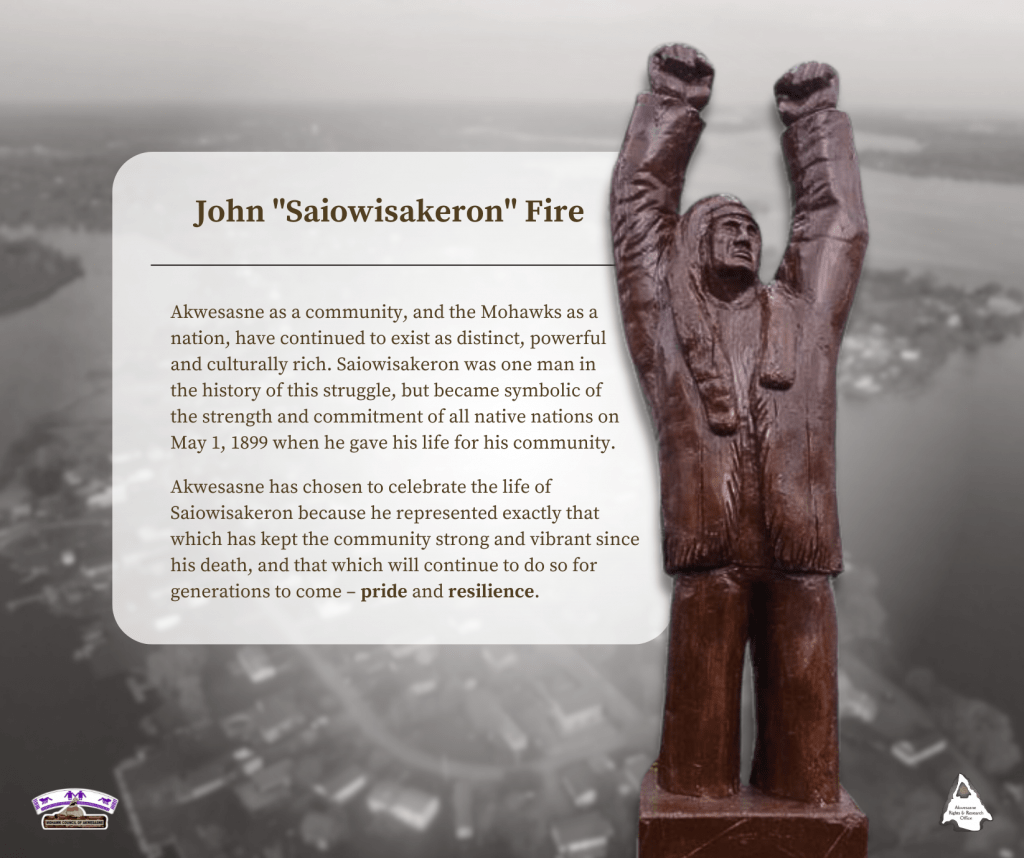THE STORY OF JOHN SAIOWISAKERON FIRE
Before there were elections in Akwesasne, the community was governed by Community Life Chiefs. These Life Chiefs were known as the Rotinonkwiseres, which means “They Have Long Hair.” These men were chosen by the Clanmothers, as is tradition among the Haudenosaunee. This was the way the community of Akwesasne had decided to choose their leaders. The new government of Canada had a plan, and a law, that were meant to change the way the Mohawks, and all Natives, governed themselves.
In an attempt to get rid of the Life Chief system, the Department of Indian Affairs of Canada created the Indian Act, which made it the law that elections could be the only way to choose leaders within Reserves. The Department sent Indian Agent’s to every Reserve to make sure that the natives started to hold elections for their leaders. In the past, Indian Agents were assigned to each Reserve by the Department of Indian Affairs to communicate between the Natives and the Federal Government, though some of these Indian Agents did not like the Natives, and took advantage of their trust. The different Native communities were not pleased with the Indian Act, and vowed to fight it. Many Clanmothers and elders began by writing letters to the different officials in the Canadian Department of Indian Affairs. When these were ignored, the Clanmothers and Life Chiefs attempted to have meetings with officials to discuss these elections. None of the officials in the government of Canada would meet with them, and eventually enough time passed that the Akwesasne community thought that Ottawa had simply given up and dropped the matter of elections. Sadly, they were wrong.
On May 1, 1899, in the village of Kana:takon, Dominion Police officers led by Lieutenant-Colonel Percy Sherwood met with Indian Agent, George Long with a plan to force the Life Chiefs to allow elections to occur, upon the threat of arrest. The Indian Agent spread word that he wanted the Chiefs and some other men to meet at his office about the possibility of work.
One of the men who were asked was a Community Life Chief named Jacob Ohnehtotake Fire. Ohnehtotake had an elder brother, John Saiowisakeron Fire. Saiowisakeron, which translates to “The Ice That Floats By,” lived with his small family – his wife Teioshirake and their daughter, Sarah. Friends nicknamed the two “Jake Ice” & “Jake Fire,” playing on the English translation of Saiowisakeron’s name. Ohnehtotake (Jake Fire) is sometimes confused with his elder brother, Saiowisakeron (Jake Ice).
Ohnehtotake went to the Indian agent’s office, not knowing the police were waiting to arrest him and his fellow Chiefs for preventing the Indian Act elections from taking place. After entering the office, and noticing the officers, shouts were exchanged, and word of the ruckus spread quickly around the village. Saiowisakeron heard that his brother was involved, and went to the Indian agent’s office to see for himself. Probably startled by the large, loud Mohawk man entering the small office, Officer Sherwood fired his gun twice, killing Saiowisakeron.
Akwesasne as a community, and the Mohawks as a nation, have continued to exist as distinct, powerful and culturally rich. Saiowisakeron was one man in the history of this struggle, but became symbolic of the strength and commitment of all native nations on May 1, 1899 when he gave his life for his community.
Akwesasne has chosen to celebrate the life of Saiowisakeron because he represented exactly that which has kept the community strong and vibrant since his death, and that which will continue to do so for generations to come – pride and resilience. Saiowisakeron was a man of integrity, honour and cultural pride.
The Mohawk Council of Akwesasne observes and celebrates this day because it supports community self-government – the right of the people to choose the style of government and laws for their own community. In observance of Saiowisakeron Day, all offices of the Mohawk Council of Akwesasne close on the first Friday in May.

